On bang to Jupiter
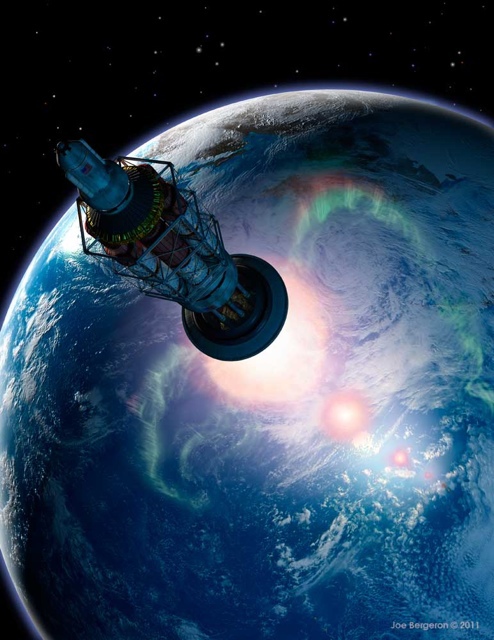
The limitations of chemical rockets were clear even before the start of regular space launches. The Tsiolkovsky formula directly says that on the engines we are accustomed to you can fly to the moon (starting on a rocket thousands of three tons of initial mass and returning in a ship of several tons), with great difficulty to fly to Mars (with many times worse ratio of initial / final mass ), but it’s impossible to conquer the Solar System on chemical rockets. Therefore, already in the middle of the twentieth century, alternative projects began to appear, the most striking of which was the atomic explosion (pulsed rocket). In this post we will talk about its design, history of creation, prospects in the 21st century, and also fly it to Jupiter in Orbiter.
Orion
The idea of the project
Atomic fission and atomic synthesis have given mankind a source of tremendous energy. Therefore, it is logical that the first to come up with the use of atomic bombs for movement in space are the developers of atomic weapons. According to the document of the Los Alamos Laboratory, Stanislav Ulam , a participant in the Manhattan Project, co-inventor of the Teller-Ulam hydrogen bomb scheme, proposed the idea of a nuclear rocket engine in 1946. According to the original idea, an atomic bomb was dropped from the ship, which exploded and evaporated a disk dropped after the bomb. In the 1950s, this idea was developed by Ted Taylor and Freeman Dyson (Dyson's sphere is also his idea). The resulting project looked like this:
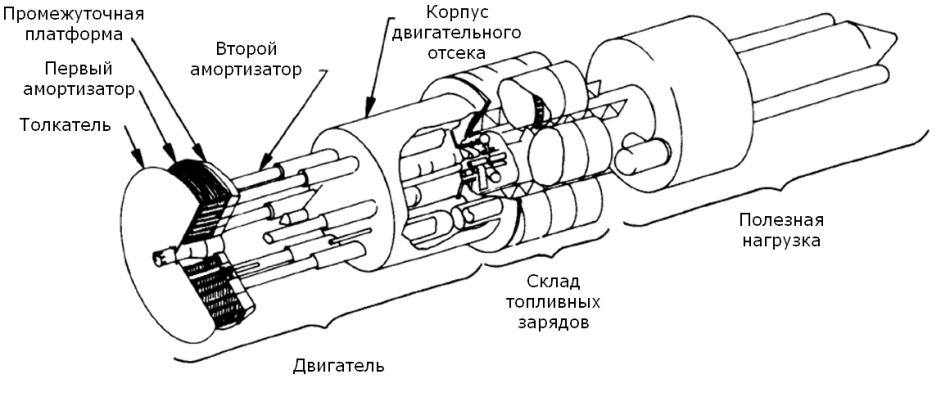
The stern plate was hit by a plasma from a nuclear charge, and the plasma impulse was transmitted to the ship through two levels of shock absorbers. Atomic devices that create a directional explosion were used as marching charges:
')
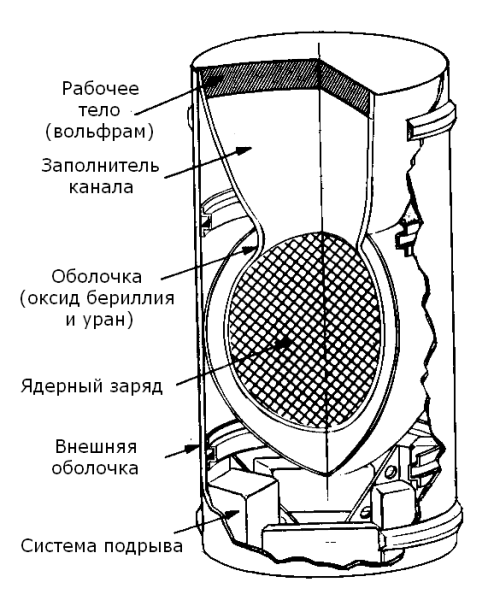
The molded shell of beryllium oxide and uranium made the explosion of a nuclear charge directed, and tungsten turned into a cigar-like plasma beam, which hit the feed plate pusher. The pusher retreated to an extremely forward position, and then, under the action of the depreciation system, returned to its original position. The cycle was repeated.

Project history
The Orion project began in 1958. It was a full-fledged engineering study, although, of course, surprising in its scale - the projects under development had a mass of 880 tons for a near-Earth ship to 8,000,000 tons for an “advanced interplanetary ship”. Scale models of the ship using conventional explosives were built to test the stability of the flight.
Very short video of one test:
The declassified chronicle of 1958, tests of various layouts:
In the 60s, the project started having problems. Firstly, the device turned out to be large and very expensive. In search of money, it turned out that the Orion had interested the military, but therefore it had to be made an armed ship. President Kennedy, having seen the mock-up of an atomic bomb with atomic cannons, rockets and other weapons, was horrified, and the chances of funding dropped sharply. Secondly, launches of all types of ships, except the smallest ones, had to be carried out from the earth on a marching nuclear engine, which meant hundreds of atomic explosions in the atmosphere, and this did not inspire anyone against the background of public protests against nuclear testing. Third, ship tests were hampered by the 1963 treaty banning nuclear tests in the atmosphere, space and under water. Nevertheless, the pusher plate was tested on a pair of nuclear tests, and, in the framework of individual explosions, the calculations were confirmed. As a result, despite the fact that at some point the Orion project was considered as a real alternative to Von Braun’s rockets and lunar program, as a result Orion was closed in the 1965 area.
Life after closing
After the project was closed, the development moved to the theoretical plane. The atomic-pulse drive promised unique opportunities, therefore on its basis began to develop interstellar ships. Freeman Dyson created two projects for the study of Alpha Centauri with a non-retarding trajectory, one per one hundred thousand tons of initial mass (0.1 US annual GDP, flight time 133 years), another ten million tons (cost 1 US annual GDP, flight 1330 years). Related "Orion" are projects "Daedalus" and "Longshot" , although they use more complex and not yet mastered engines. The project “Medusa” was also invented, where a special parachute was used instead of the pusher plate. Despite the fact that no one starts to implement projects and does not give money, groups of enthusiasts come up with new projects. For example, in 2007, an article appeared describing Mini-Mag Orion , a small Orion, in which the atomic charges were blown up by a magnetic field.
Project Evaluation
Advantages:
- "Orion" we realize already at the level of technology forty years ago.
- A unique engine combining high thrust and high specific impulse. Chemical missiles have a large thrust, but a small impulse; in electric propulsion, a large impulse, but a small thrust.
- The possibility of interstellar travel. Nuclear "Orion" theoretically can accelerate to 3% -5% of the speed of light, thermonuclear - 8% -10%, on a thermonuclear drive with annihilation catalysis - 10% and on the annihilation "matter-antimatter" - 50% -80%. A flight to Alpha Centauri by 0.1 s will take 44 years and 36 days each to accelerate / decelerate with an acceleration of 1 g.
Disadvantages:
- Pollution of the Earth by products of nuclear explosions when starting from the Earth and flying in the atmosphere.
- The presence of moving parts, it requires unconditional reliability of the second shock absorber under the conditions of thousands of explosions.
- The use of atomic charges is a problem of control and safety.
- Big and expensive. A vicious circle - as long as there is no serious need to bring thousands of tons into orbit, no one will give money to develop an aggregate that these thousands of tons can bring out, and the need will not appear.
A little thought
In the coming decades, humanity is unlikely to begin building interstellar ships, unless, of course, there are any happy inventions. Therefore, it is difficult to talk about the most applicable technology for interstellar flights. However, at the current technological level, Orion looks quite good relative to other methods of movement. According to NASA , the design specific impulse of the explosion was in the range of 1800-6000 seconds, and in the 1980s, with the development of technology, the UI was promised 10-20 thousand seconds. Curiously enough, similarly, electric propulsion engines have already reached similar indicators (electric propulsion with a UI of 1600 s has already flown, promising electric propulsion promises up to 20 000 s). Perhaps the Solar System will be conquered not by a brutal atomic explosion, but by a “cultural” ERE. But we cannot do without atomic devices on ships - only they can provide the required amounts of energy for the development of the Solar system.
Flight
If you are not interested in flying to Jupiter on a blast, watch this video on the flight to Mars to get an idea of what we are planning to do, and you can skip the rest of the post:
Flight preparation
In addition to Orbiter, we only need one addon - Orion 1.22 . It is also assumed that you at least read my posts on the Orbiter tag and have an understanding of the terminology.
Some theory
In cosmic ballistics, there is the concept of “Gomanov trajectory” (Hohmann transfer orbit). This is the path of the most economical movement between orbits. It consists of two pulses, the first of which is given in the pericenter and raises the apocenter to the desired height, and the second is given in the apocenter and raises the pericenter to the desired height. If we want to move to a lower orbit, then the actions are reversed. The first is the lowering of the pericenter, the second is the lowering of the apocenter. Here is a picture illustrating the idea:
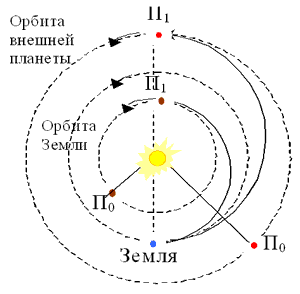
Obviously, if we are flying, for example, to Jupiter, it will not always be at the opposite point of the orbit to the start point by the time we arrive there. Therefore, the Gohman trajectory is possible only at certain time intervals - starting windows. Outside the start window, the flight is possible, but it will require more fuel and will be more difficult.
Also, planning our flight to Jupiter, we assume that we are flying “by eye”, manually, without serious ballistic calculations or additional MFDs. Therefore, our flight will be very inefficient in terms of fuel costs, but interesting, and we will arrive with excellent accuracy for the flight by eye.
Flight plan
Our flight will consist of the following stages:
- Acceleration from orbit of the Earth.
- Correction of the trajectory after leaving the zone of gravitational influence of the Earth.
- Trajectory correction - the combination of orbital inclinations (the orbit of the Earth and the orbit of Jupiter have a slightly different inclination).
- If necessary - correction of the trajectory when approaching Jupiter.
- Go to orbit around Jupiter.
Stage 1. Acceleration from Earth's orbit
We need the “Orion 20m” script, in which the starting window to Jupiter is open:

The Russian version of the launcher can be found here .
At the first stage, the most important for us is Transfer MFD. Switch the left MFD to Transfer mode ( Left Shift - F1 , Left Shift - X ). As the reference body, select Sun ( Left Shift - R , select Sun in the menu). Select the launch mode from the orbit of another celestial body ( Left Shift - S , select Earth ). MFD will look like this:

On the left - the original view, on the right - an explanation of the display.
Select Jupiter as the target ( Left Shift - T , select Jupiter in the menu). Turn on the HTO mode (the HTO button on the MFD), move the starting point slightly forward from our location ( Left Shift - </> ) and set the calculated speed increment to the orbit of Jupiter using the Left Shift - ± keys. The result will be:
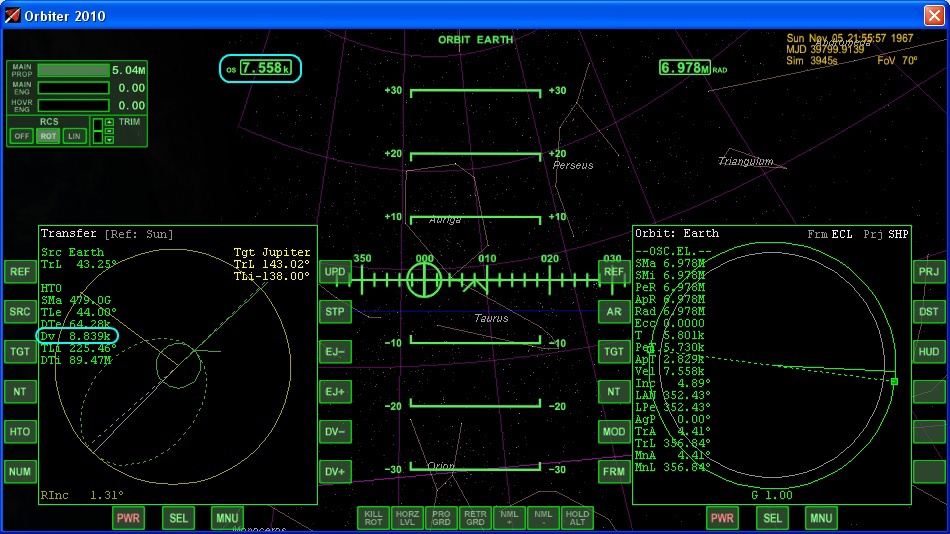
A small discrepancy between the point of tangency of the orbit and the position of Jupiter is not terrible, we will fix it later.
For overclocking, we need two parameters:
The final velocity is calculated as the current orbital velocity OS + speed increment dV. Both parameters are highlighted in the screenshot. We calculate: OS + dV = 7,558 k + 8,839 k = 16, 397 k, i.e. 16.4 km / s Considering that we will move away from the Earth every second, and our speed will decrease, it’s better to take the speed 1-2 km / s lower as the final speed, i.e. our final speed will be 15 km / s , then fix it.
Direction of the acceleration vector . From the point of view of ballistics, a zero step would be needed - a decrease in the orbit inclination or an amendment to the orbit inclination during acceleration. Fortunately, in the scenario, the inclination of the initial orbit is not significant. Turn on the auto-maintain position along the orbital velocity vector (Prograde, [ ) We wait until we are in orbit on the Sun-Earth line from the outside (in the shade), at this moment the short line of the indicator forms a straight line with the Sun-Earth line:

At this moment we stabilize the ship with the KillRot mode ( Num 5 ). We will accelerate at the next turn. The Orion engine is very powerful, so we start acceleration when the orbital speed vector is 8-10 degrees:
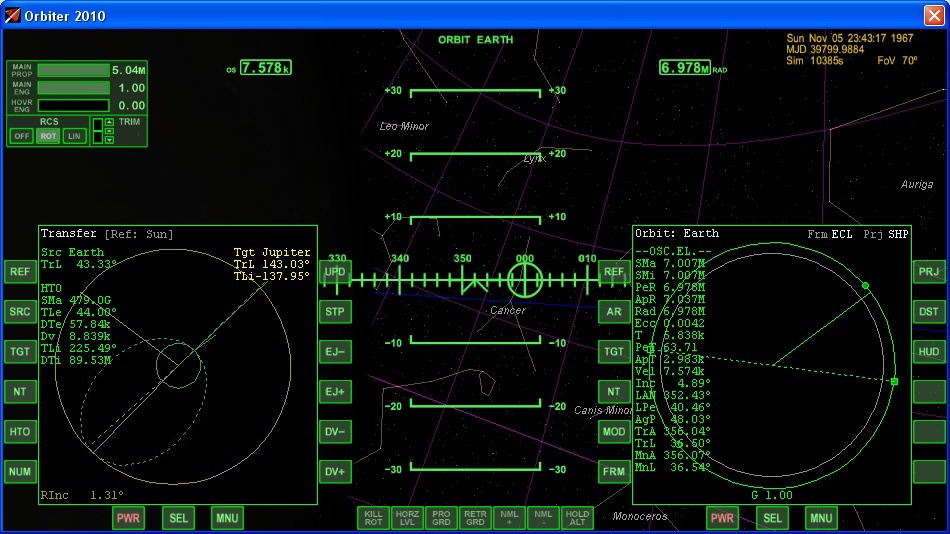
Handsomely:

Upon reaching the required speed, turn off the engine. The hyperbolic runaway orbit is visible on the right MFD.
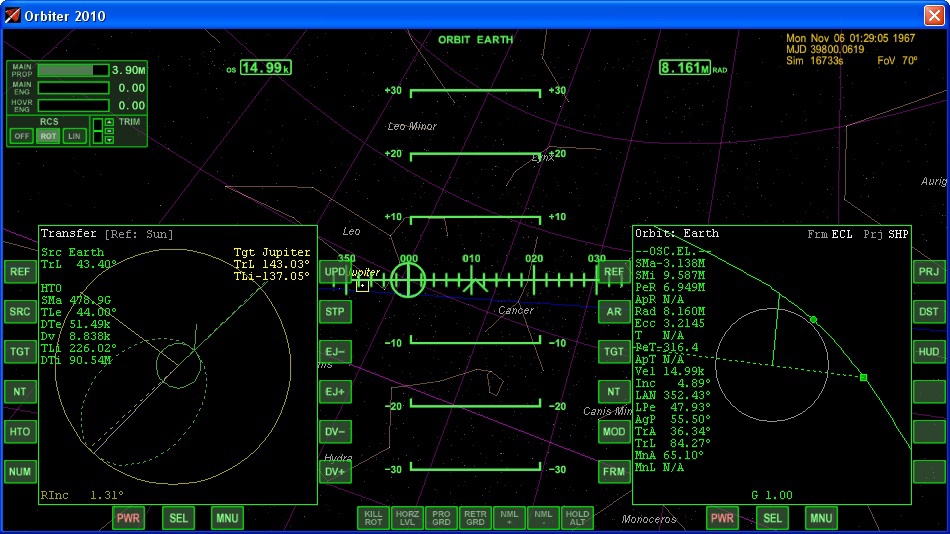
Fly us far away, so here's the ambient on the road:
Stage 2. Correction of the trajectory after leaving the zone of gravitational influence of the Earth
By accelerating the time, we flush the flight for as long as the influence of the Earth (G at the bottom of the right MFD) is less than 0.05. Switch the left MFD to tracking us, not Earth ( Left Shift - S , By name , enter the name of the ship Lewis ).

Oops, we are too overclocked. So, first, we need to slow down.

The next problem is that, despite our efforts, Jupiter will be behind us when we find ourselves in its orbit. Therefore, we need to shift the orbit clockwise. To do this, we occupy a position at an angle of 90 degrees to the orbital velocity vector, manually, there is no such autopilot.

We occupy the required position and turn on the engine. The ship on the course of 90 degrees must be held manually, fortunately, it is not difficult. From the point of view of ballistics, such a maneuver is barbarism, but, nevertheless, it works:
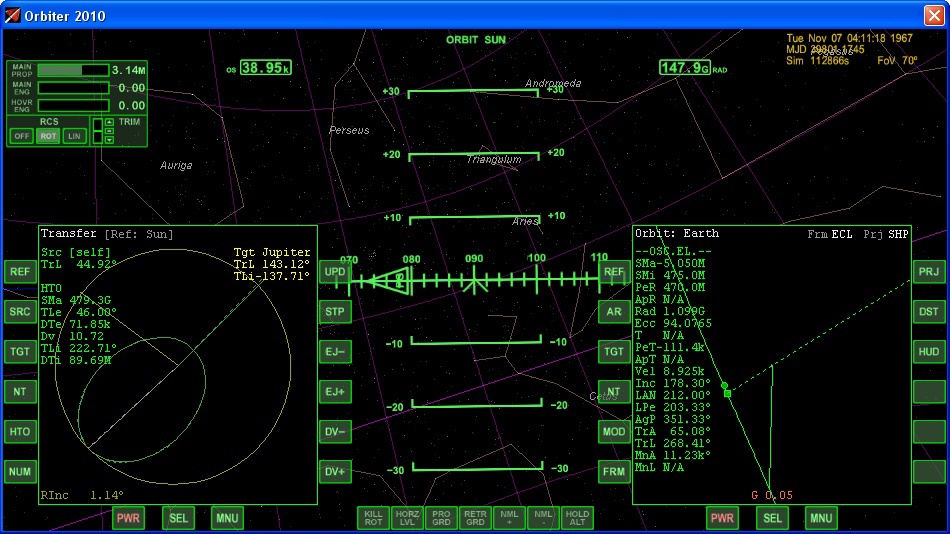
Switch the right MFD to the mode of combining the orbits inclinations ( Right Shift - F1 , right Shift - A ), select Jupiter ( Right Shift - T , Jupiter to choose in the menu).

The next node we have is descending (Descending Node), so the correction should be "up" from the plane of flight. Tips ignore, flush time to the descending node.
Stage 3. Path correction - the combination of orbital inclinations.
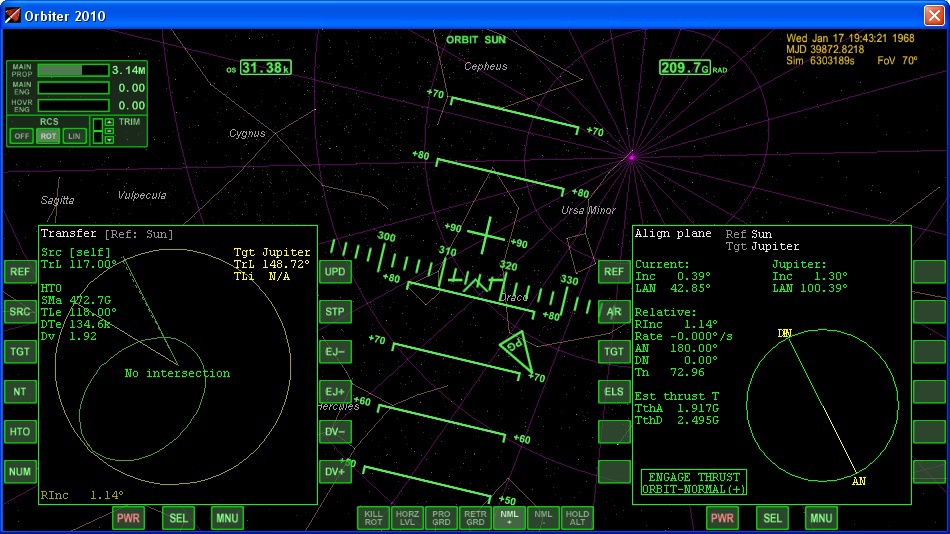
It turns out that the Earth still slowed us down a bit. Therefore, besides combining the orbits, we will also perform a trajectory correction. Hint: the ship has very powerful orientation engines, small displacements can be given by them in a linear mode.
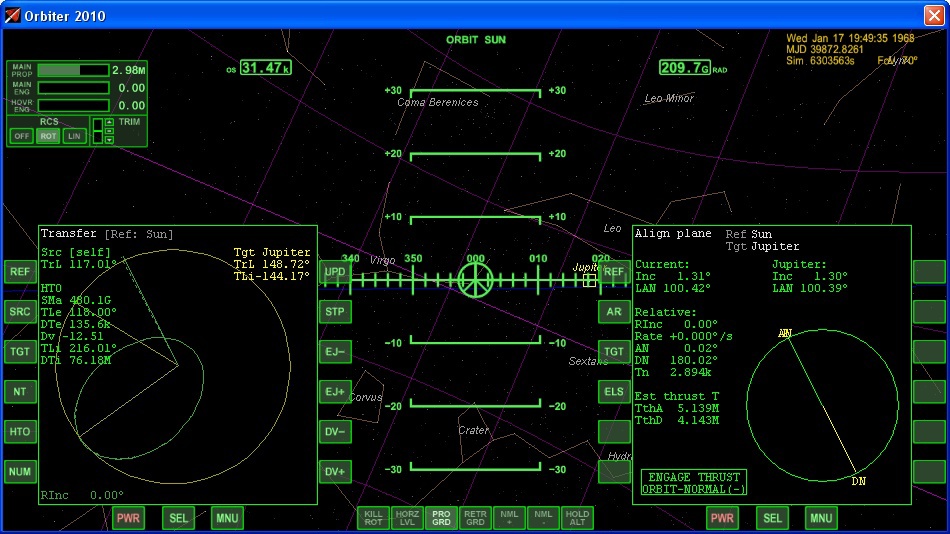
A rough correction is made. Let's make an exact correction here. Switch the right MFD to Sync Orbit mode ( Right Shift - F1 , right Shift - Y , select target right Shift - T , select Jupiter) and, recalling the docking post, maneuvering, reduce the DTmin parameter to a value close to zero.
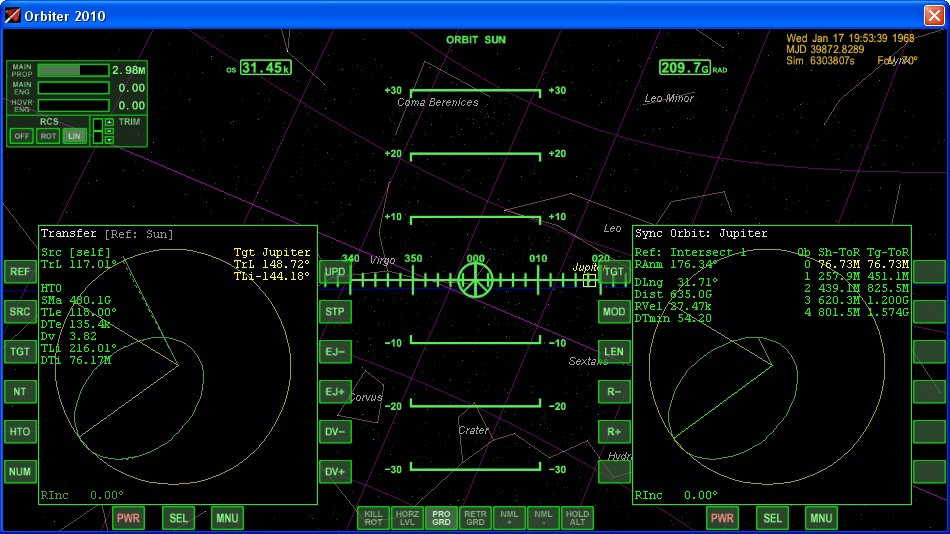
Something like this. The value will fluctuate, this is normal. Now we turn on the acceleration before approaching Jupiter and wait a long time.
Stage 4. Correction of the trajectory when approaching Jupiter.
We had a good correction, so this stage is not needed. But if you have grown DTmin more than a million, or there are other signs of the need for correction, you can spend it on approaching Jupiter. But do not strive to reduce DTmin completely to zero, otherwise you will have to dodge Jupiter in order to go into orbit and not crash into it.
Stage 5. Transition to orbit around Jupiter.
Flying up to Jupiter, we will transfer the left MFD to the Orbit mode ( Left Shift - F1 , left Shift - O , choose the body of the appeal left Shift - R , Jupiter ). Let us verify that we will fly past, and not crash into the planet. In Orbiter, Jupiter is very beautiful, showing the effect of a rotating atmosphere. Let's wait for the pericenter, turn the ship against the orbital velocity vector and start braking.

Everything, we flew!
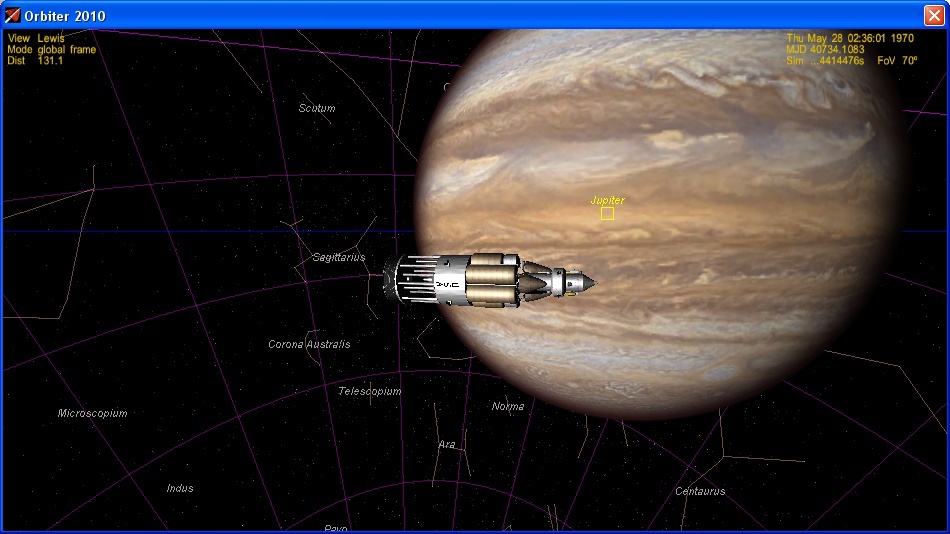
Conclusion
Russian manual .
For navigation: posts on the "Orbiter" tag.
Source: https://habr.com/ru/post/225549/
All Articles